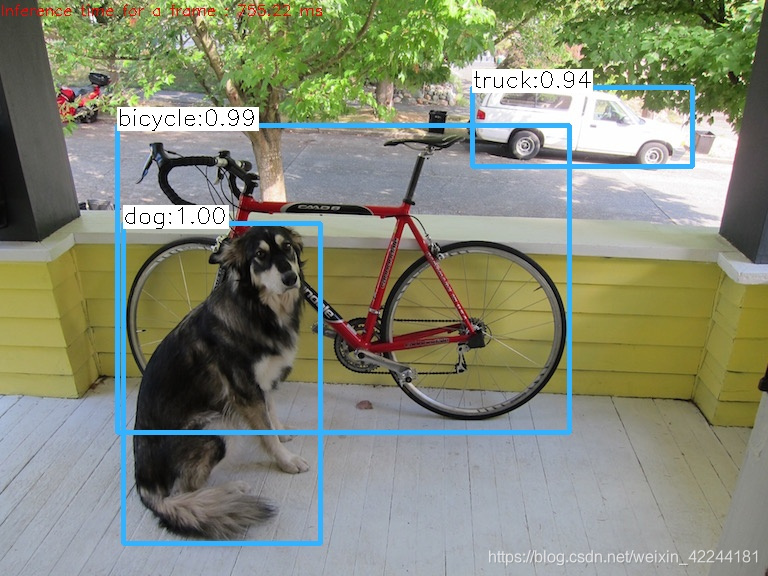参考 https://blog.csdn.net/LuohenYJ/article/details/88537253
实现效果图




下载预训练模型放入工程目录,放入待检测图片
yolov3.cfg
yolov3.weights
coco.names

#include <fstream>
#include <sstream>
#include <iostream>
#include <time.h>
#include <opencv2/dnn.hpp>
#include <opencv2/imgproc.hpp>
#include <opencv2/highgui.hpp>
using namespace cv;
using namespace dnn;
using namespace std;
// Initialize the parameters 初始参数
// Confidence threshold 置信度阈值
float confThreshold = 0.5;
// Non-maximum suppression threshold 非极大性抑制阈值
float nmsThreshold = 0.4;
//检测图像宽高
int inpWidth = 416;
int inpHeight = 416;
//类别参数
vector<string> classes;
// Remove the bounding boxes with low confidence using non-maxima suppression
// 基于非极大性抑制去除低置信度的检测框
void postprocess(Mat& frame, const vector<Mat>& out);
// 画预测框
void drawPred(int classId, float conf, int left, int top, int right, int bottom, Mat& frame);
// 提取输出输出层
vector<String> getOutputsNames(const Net& net);
int main()
{
// Give the configuration and weight files for the model 模型参数文件
String modelConfiguration = "yolov3.cfg";
String modelWeights = "yolov3.weights";
// Load names of classes 读取分类类名
string classesFile = "coco.names";
ifstream ifs(classesFile.c_str());
string line;
while (getline(ifs, line))
{
classes.push_back(line);
}
// Load the network 导入网络
Net net = readNetFromDarknet(modelConfiguration, modelWeights);
net.setPreferableBackend(DNN_BACKEND_OPENCV);
//仅仅使用CPU
net.setPreferableTarget(DNN_TARGET_CPU);
// Open a video file or an image file or a camera stream.
string str, outputFile;
Mat blob;
clock_t start, finish;
//读图
Mat frame = imread("dog.jpg");
//根据需求决定是不是重置图像
//resize(frame, frame, Size(300, 300));
start = clock();
// Create a 4D blob from a frame. 创建神经网络输入图像
blobFromImage(frame, blob, 1 / 255.0, cvSize(inpWidth, inpHeight), Scalar(0, 0, 0), true, false);
//Sets the input to the network 设置输出
net.setInput(blob);
// Runs the forward pass to get output of the output layers 获取输出层结果
vector<Mat> outs;
net.forward(outs, getOutputsNames(net));
// Remove the bounding boxes with low confidence
postprocess(frame, outs);
finish = clock();
cout << "time is " << double(finish - start) / CLOCKS_PER_SEC << endl;
// Put efficiency information. The function getPerfProfile returns the overall time for inference(t) and the timings for each of the layers(in layersTimes)
//输出前向传播的时间
vector<double> layersTimes;
double freq = getTickFrequency() / 1000;
double t = net.getPerfProfile(layersTimes) / freq;
string label = format("Inference time for a frame : %.2f ms", t);
putText(frame, label, Point(0, 15), FONT_HERSHEY_SIMPLEX, 0.5, Scalar(0, 0, 255));
imshow("result", frame);
//保存图像
imwrite("result.jpg", frame);
waitKey(0);
return 0;
}
/**
* @brief Remove the bounding boxes with low confidence using non-maxima suppression 基于非极大性抑制去除边框
*
* @param frame 视频图像
* @param outs 输出层结果
*/
void postprocess(Mat& frame, const vector<Mat>& outs)
{
//输出类
vector<int> classIds;
//置信度
vector<float> confidences;
vector<Rect> boxes;
//遍历所有的输出层
for (size_t i = 0; i < outs.size(); ++i)
{
// Scan through all the bounding boxes output from the network and keep only the
// ones with high confidence scores. Assign the box's class label as the class
// with the highest score for the box.
//扫描所有来自网络的边界框输出,只保留具有高置信度分数的边界框。将框的类标签指定为框得分最高的类。
//读取框
float* data = (float*)outs[i].data;
for (int j = 0; j < outs[i].rows; ++j, data += outs[i].cols)
{
Mat scores = outs[i].row(j).colRange(5, outs[i].cols);
Point classIdPoint;
double confidence;
// Get the value and location of the maximum score 获取置信度和位置参数
minMaxLoc(scores, 0, &confidence, 0, &classIdPoint);
//如果大于置信度阈值
if (confidence > confThreshold)
{
//获取坐标
int centerX = (int)(data[0] * frame.cols);
int centerY = (int)(data[1] * frame.rows);
int width = (int)(data[2] * frame.cols);
int height = (int)(data[3] * frame.rows);
int left = centerX - width / 2;
int top = centerY - height / 2;
classIds.push_back(classIdPoint.x);
confidences.push_back((float)confidence);
boxes.push_back(Rect(left, top, width, height));
}
}
}
// Perform non maximum suppression to eliminate redundant overlapping boxes with
// lower confidences
//输出非极大性抑制结果,按置信度从大到小输出
vector<int> indices;
//非极大性抑制
NMSBoxes(boxes, confidences, confThreshold, nmsThreshold, indices);
//绘图
for (size_t i = 0; i < indices.size(); ++i)
{
int idx = indices[i];
Rect box = boxes[idx];
//类,置信度
drawPred(classIds[idx], confidences[idx], box.x, box.y,
box.x + box.width, box.y + box.height, frame);
}
}
/**
* @brief Draw the predicted bounding box 画框
*
* @param classId 类别
* @param conf 置信度
* @param left
* @param top
* @param right
* @param bottom
* @param frame
*/
void drawPred(int classId, float conf, int left, int top, int right, int bottom, Mat& frame)
{
//Draw a rectangle displaying the bounding box
rectangle(frame, Point(left, top), Point(right, bottom), Scalar(255, 178, 50), 3);
//Get the label for the class name and its confidence
string label = format("%.2f", conf);
if (!classes.empty())
{
CV_Assert(classId < (int)classes.size());
label = classes[classId] + ":" + label;
}
//Display the label at the top of the bounding box 在每个框左上角标上标签
int baseLine;
Size labelSize = getTextSize(label, FONT_HERSHEY_SIMPLEX, 0.5, 1, &baseLine);
top = max(top, labelSize.height);
rectangle(frame, Point(left, top - round(1.5*labelSize.height)), Point(left + round(1.5*labelSize.width), top + baseLine), Scalar(255, 255, 255), FILLED);
putText(frame, label, Point(left, top), FONT_HERSHEY_SIMPLEX, 0.75, Scalar(0, 0, 0), 1);
}
// Get the names of the output layers 获取输出层
/**
* @brief Get the Outputs Names object
*
* @param net
* @return vector<String>
*/
vector<String> getOutputsNames(const Net& net)
{
//输出
static vector<String> names;
if (names.empty())
{
//Get the indices of the output layers, i.e. the layers with unconnected outputs
vector<int> outLayers = net.getUnconnectedOutLayers();
//get the names of all the layers in the network
vector<String> layersNames = net.getLayerNames();
// Get the names of the output layers in names
names.resize(outLayers.size());
for (size_t i = 0; i < outLayers.size(); ++i)
{
names[i] = layersNames[outLayers[i] - 1];
}
}
return names;
}
